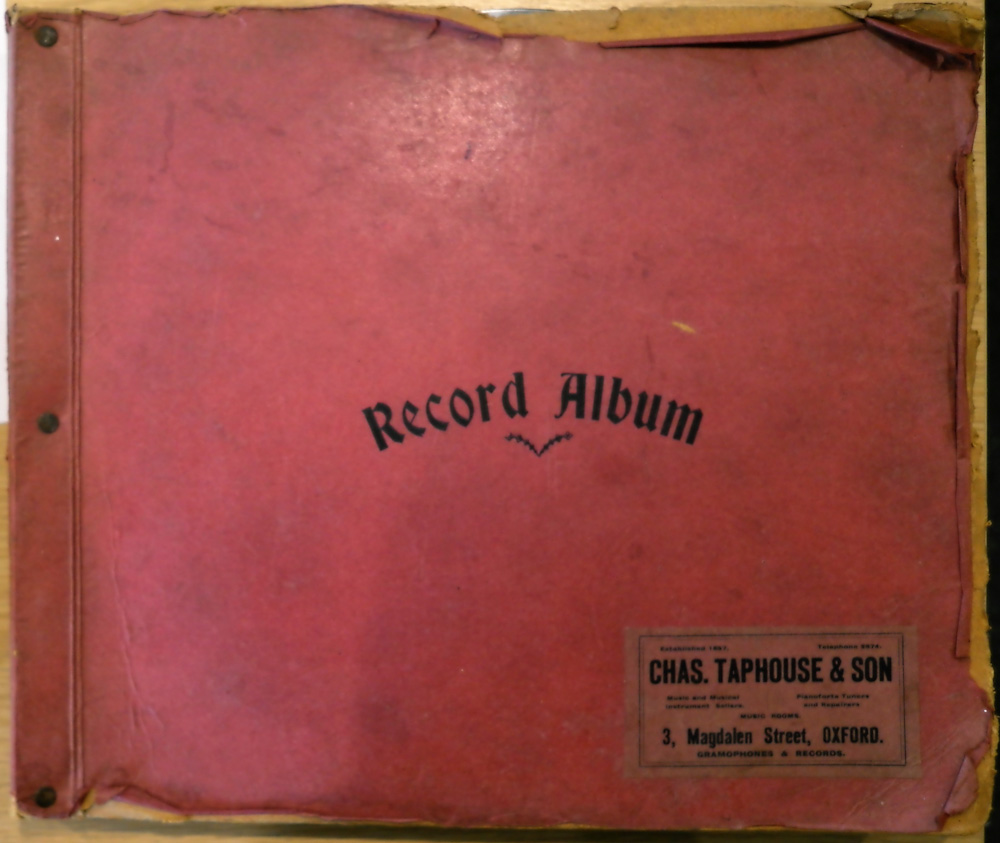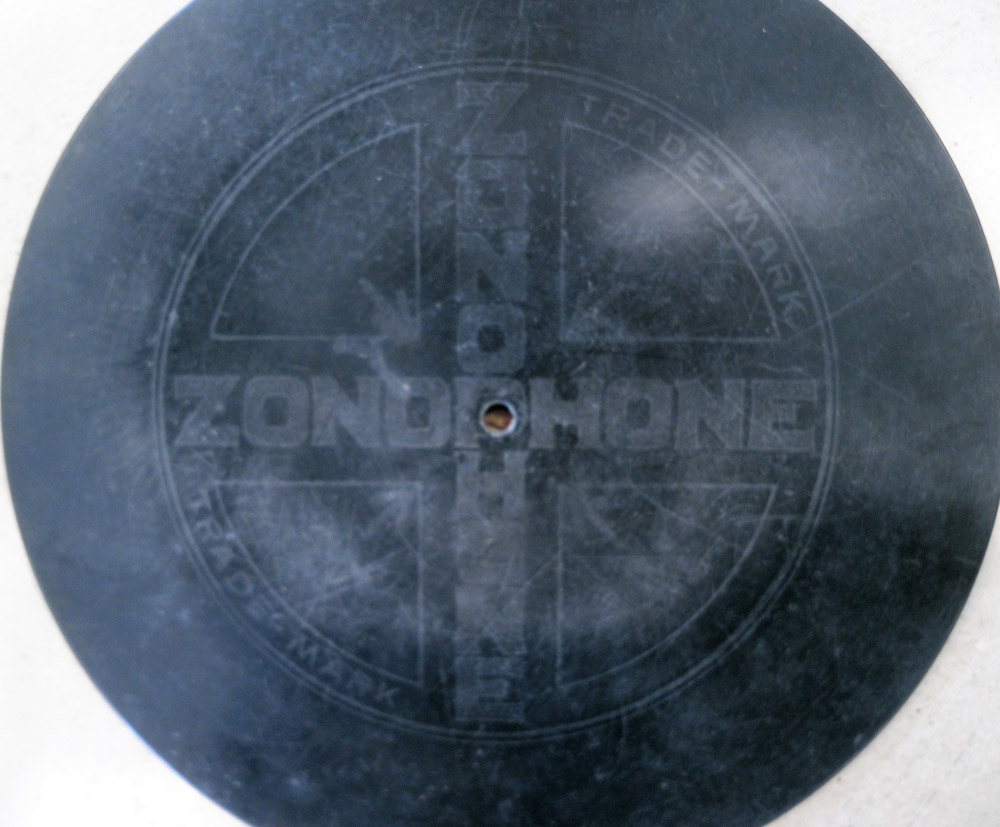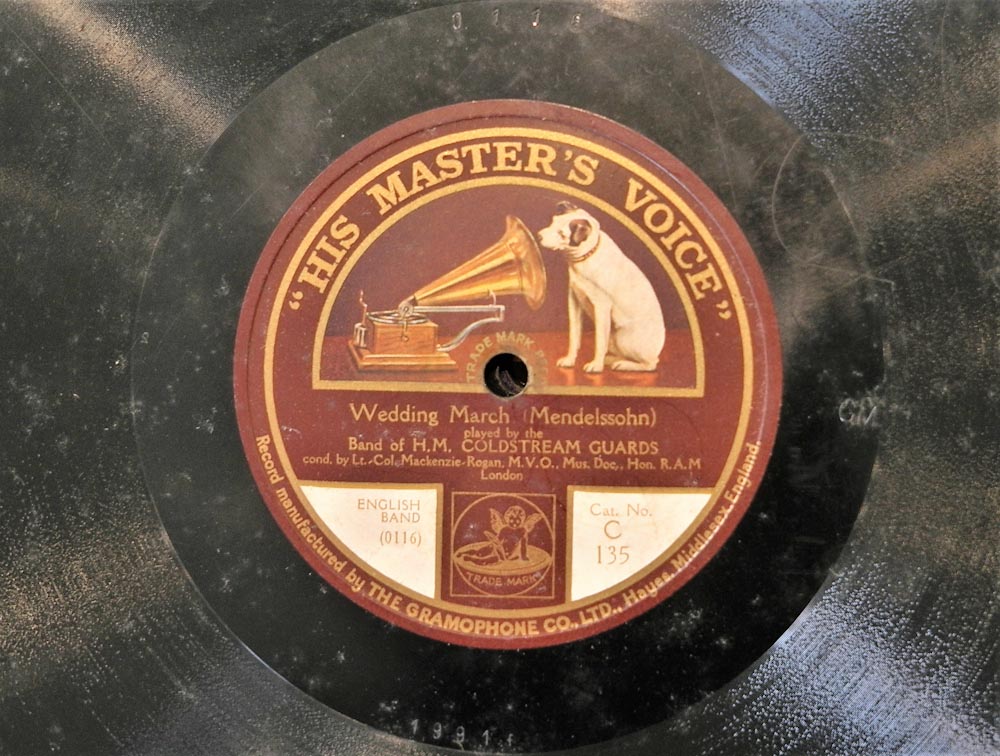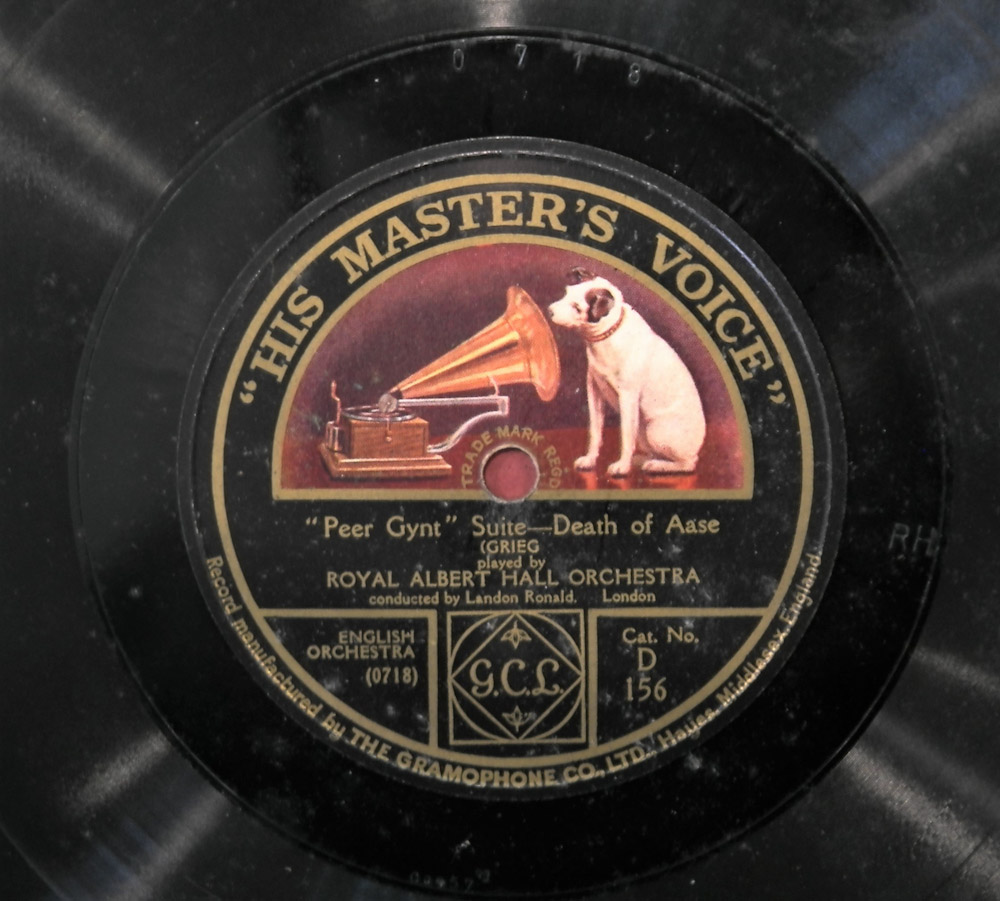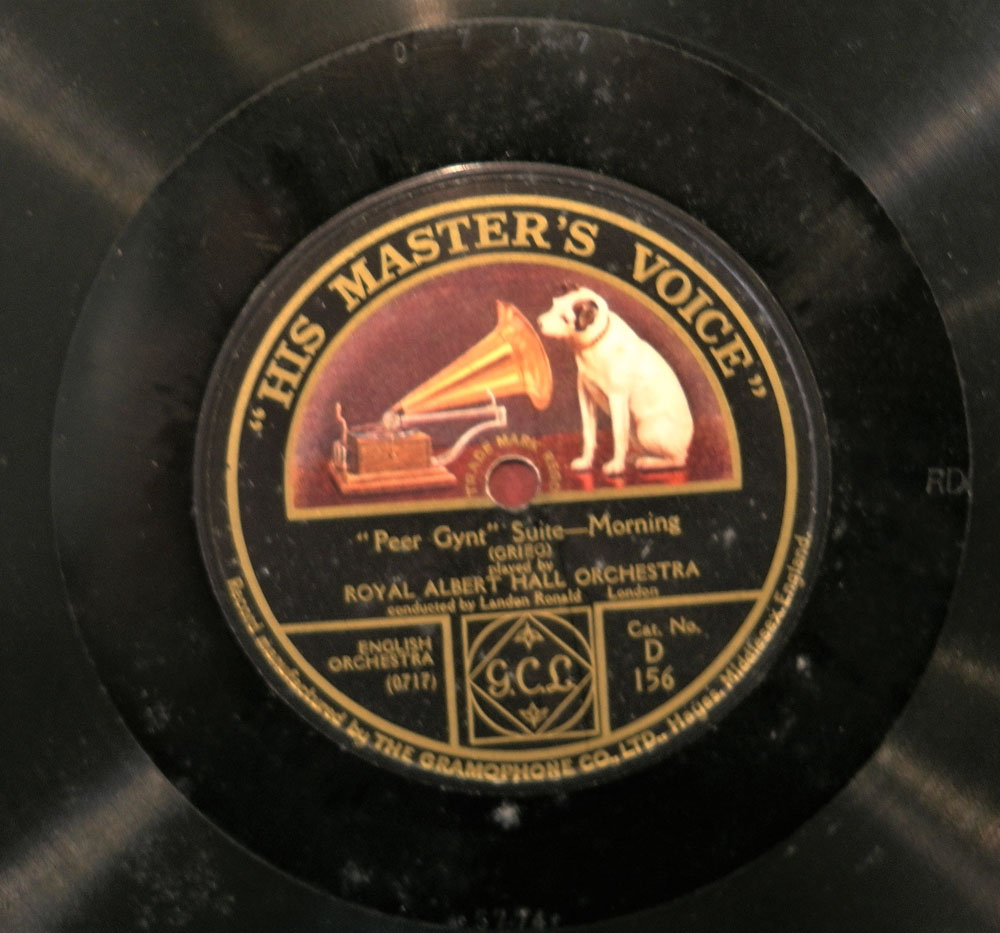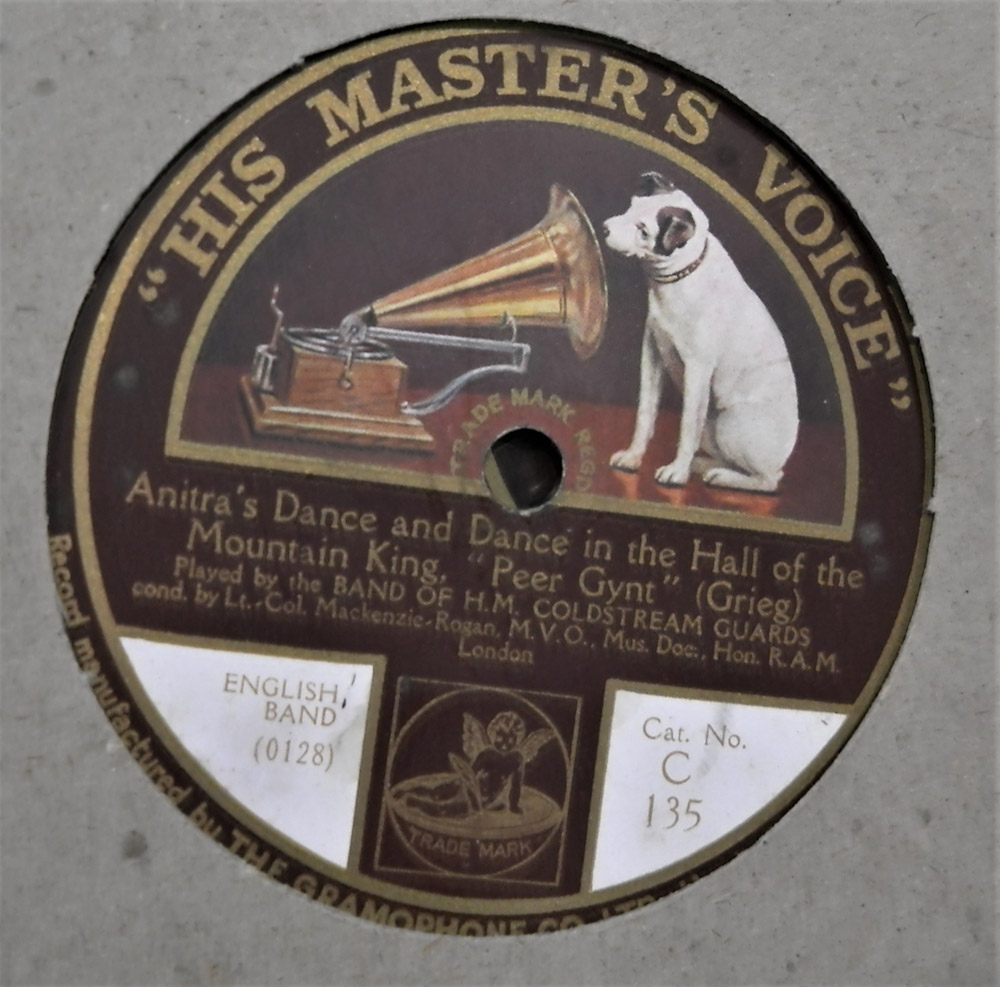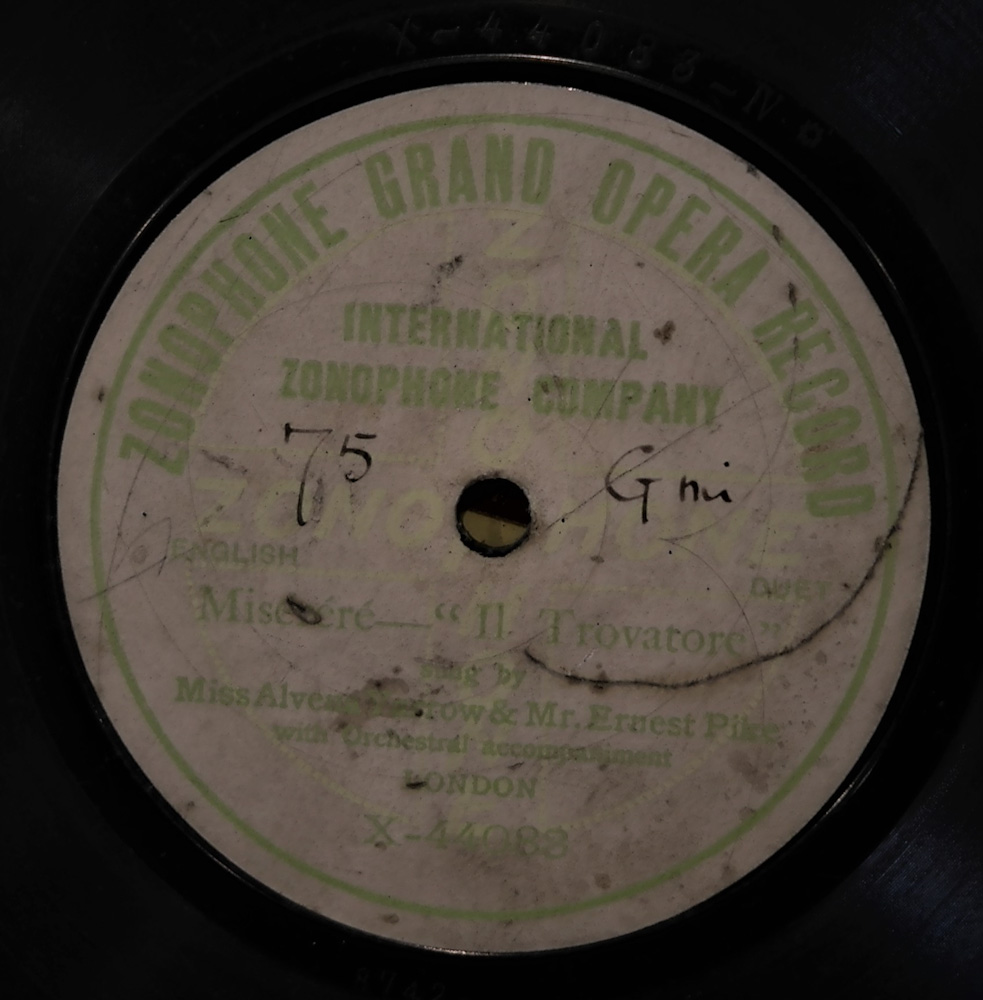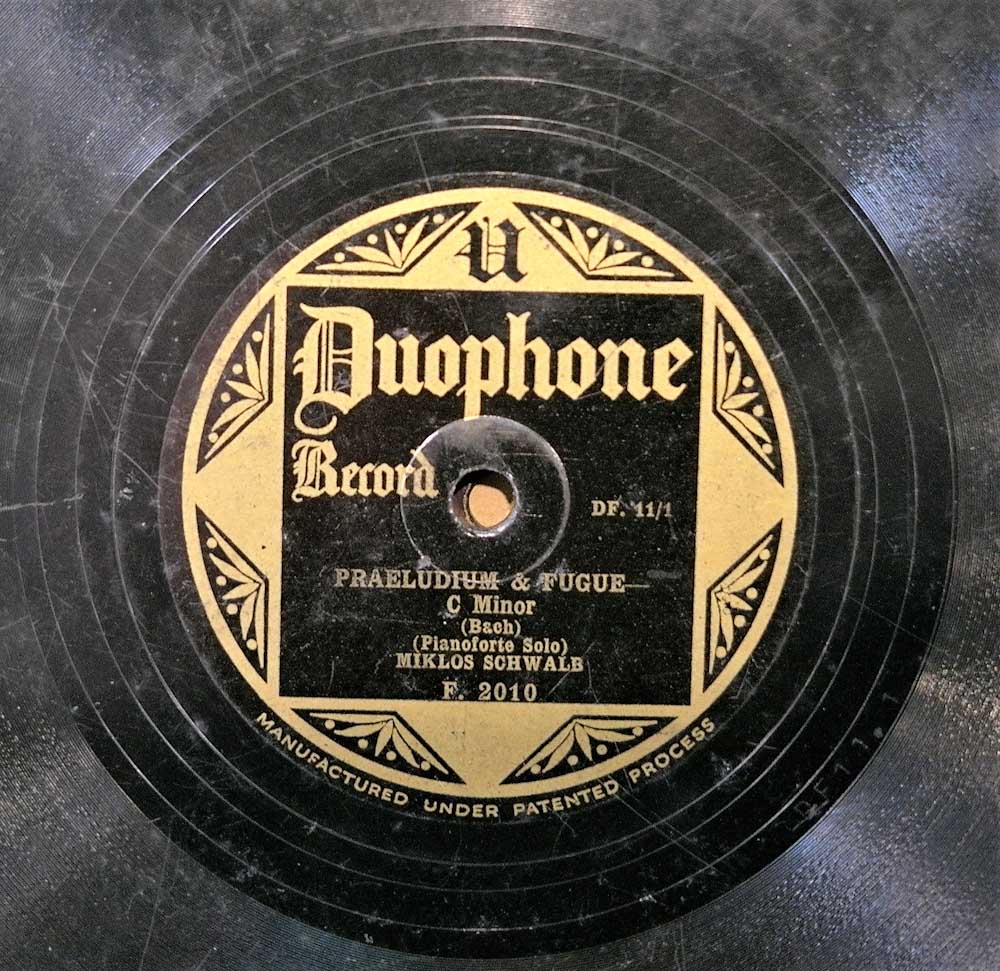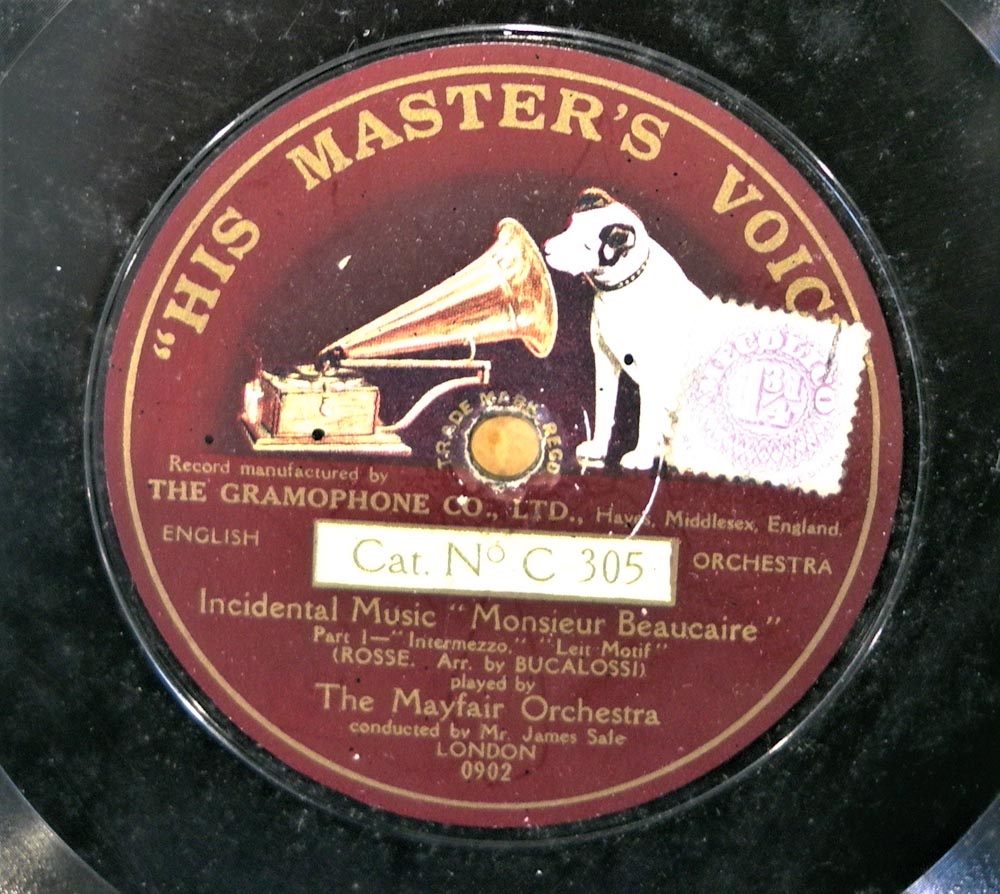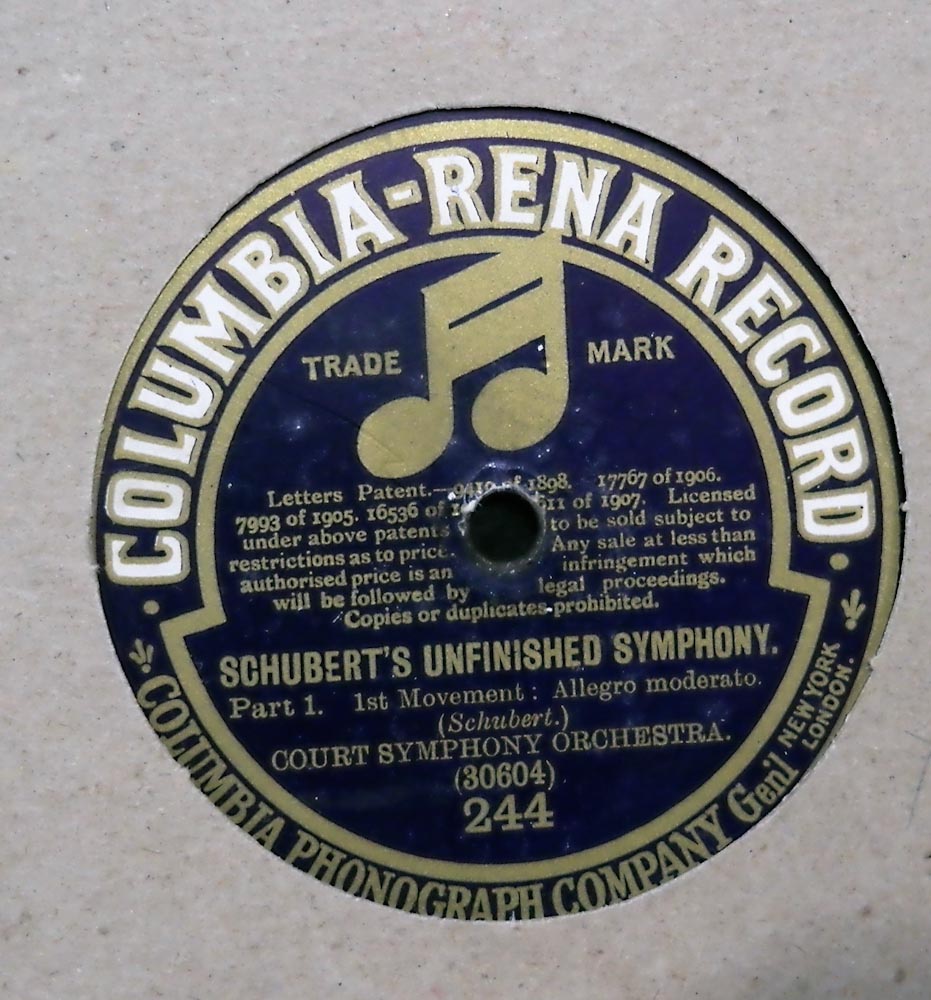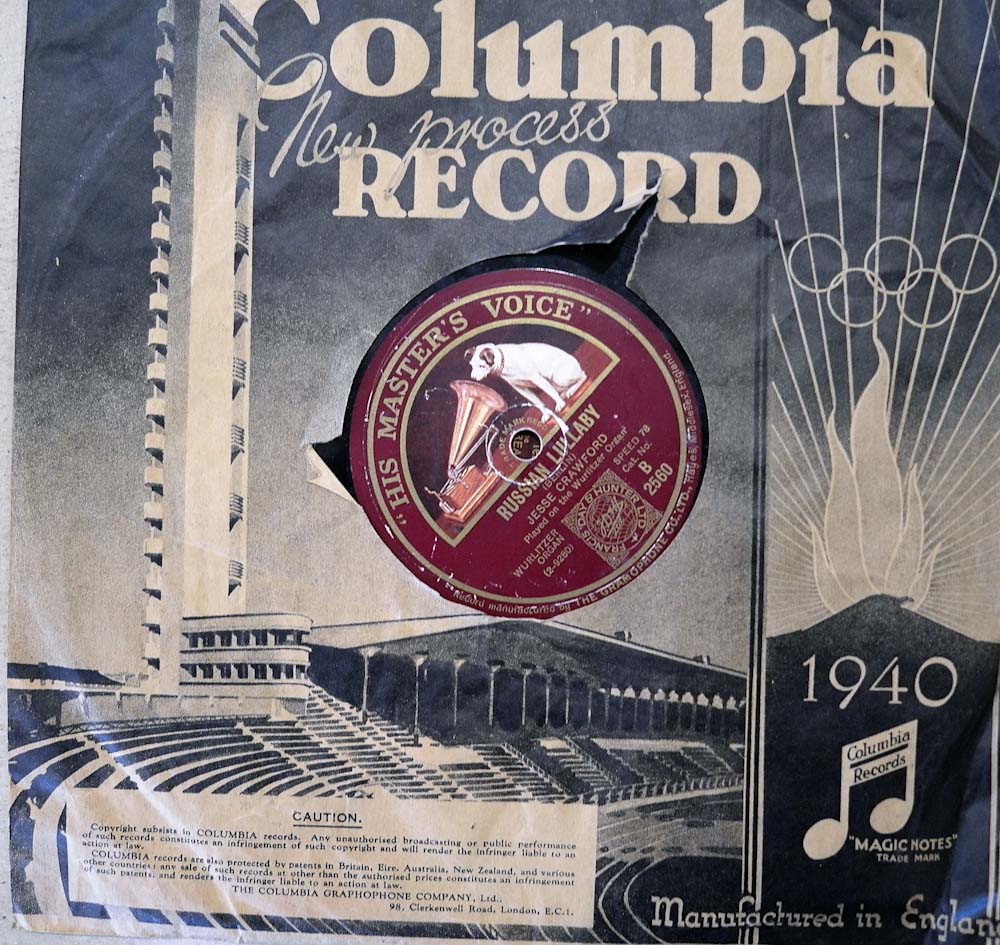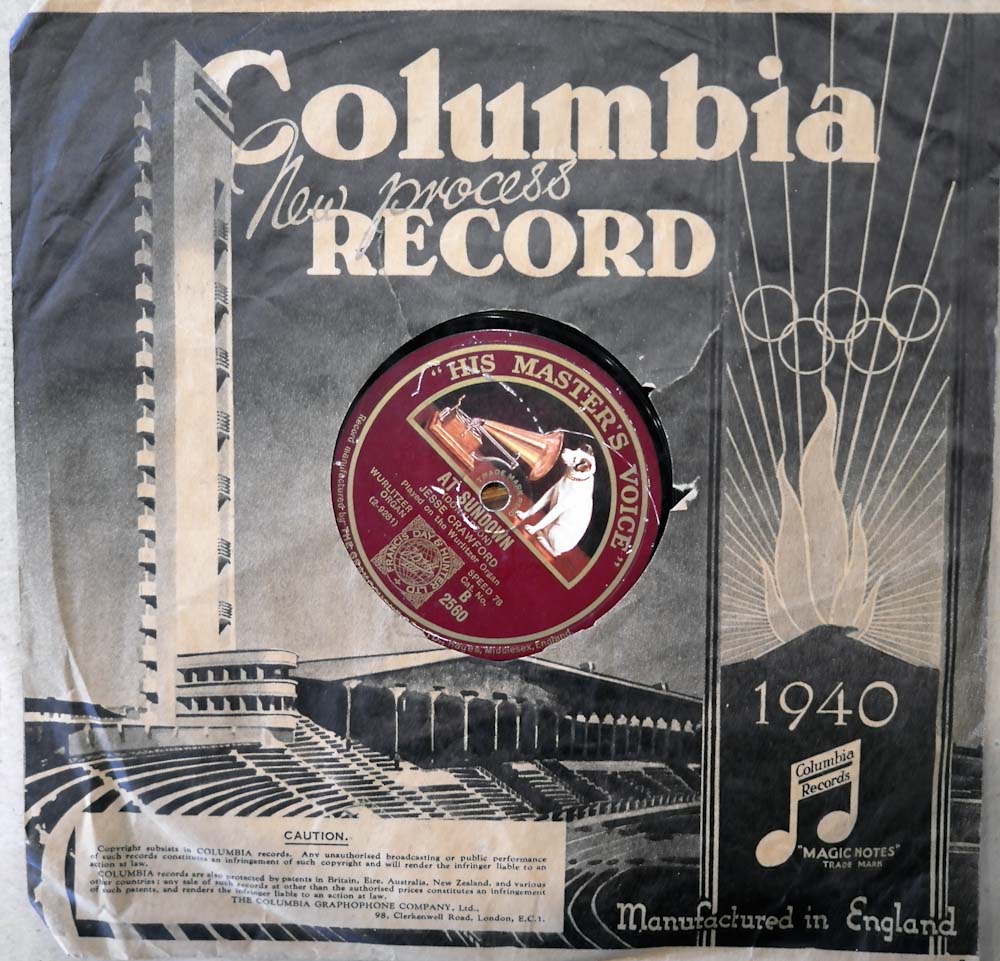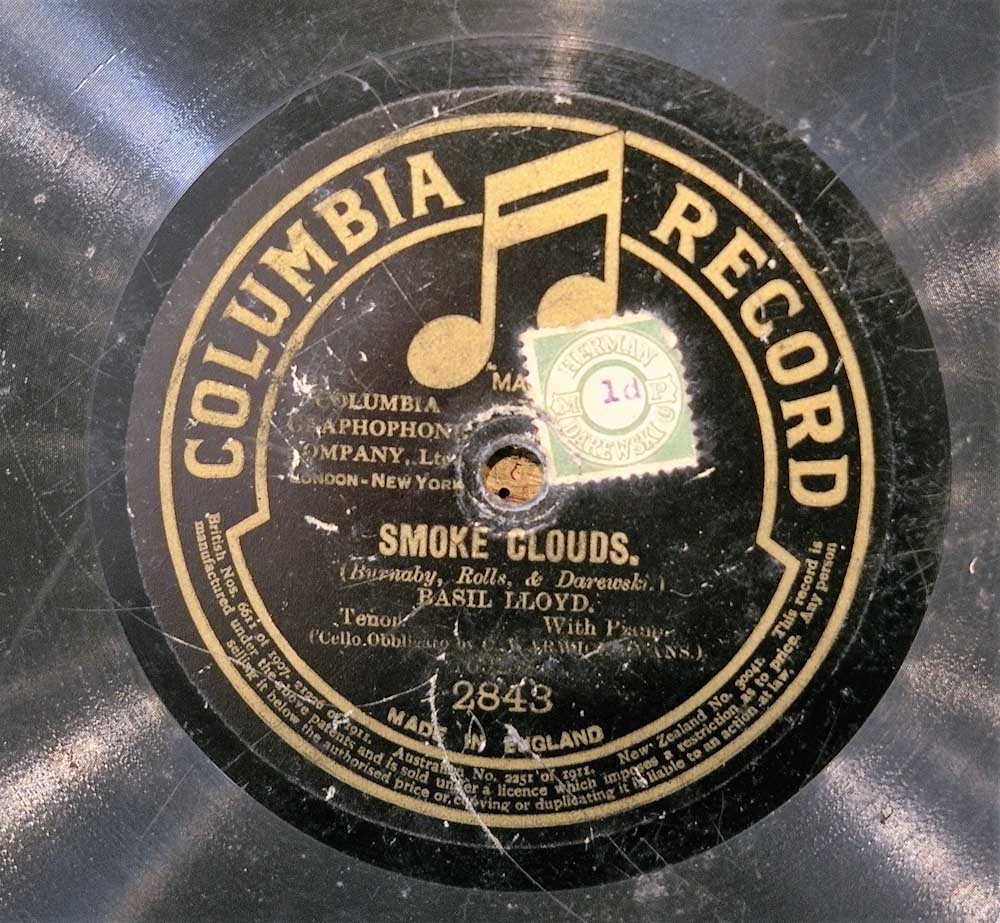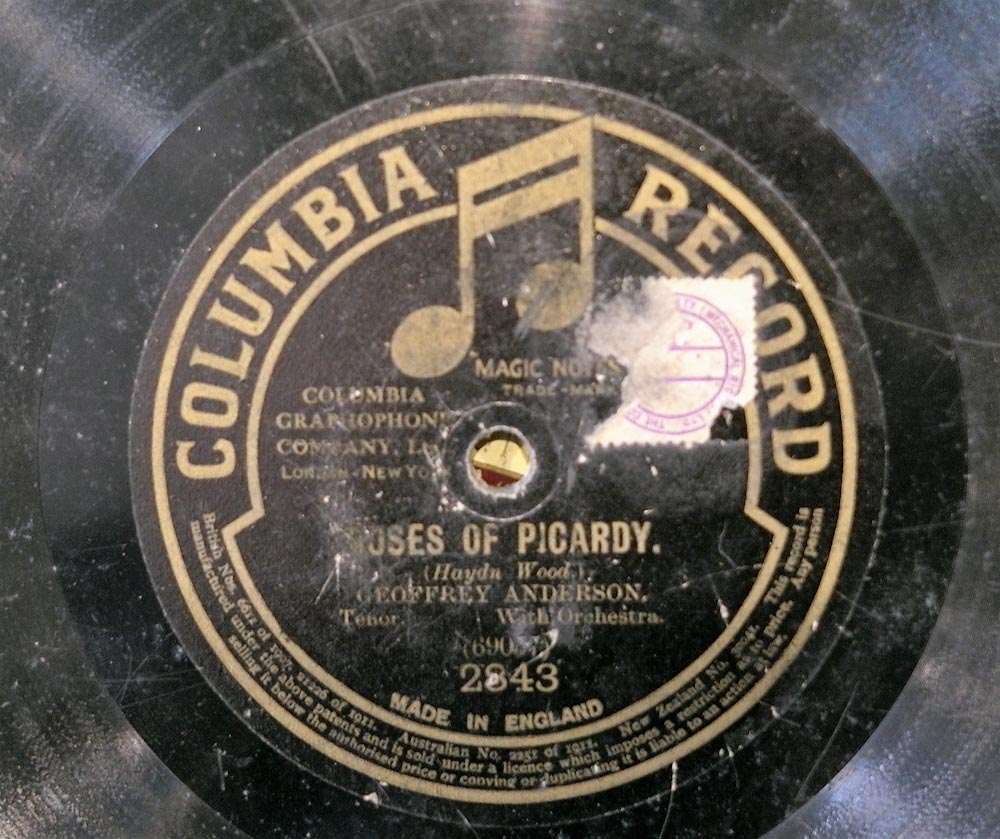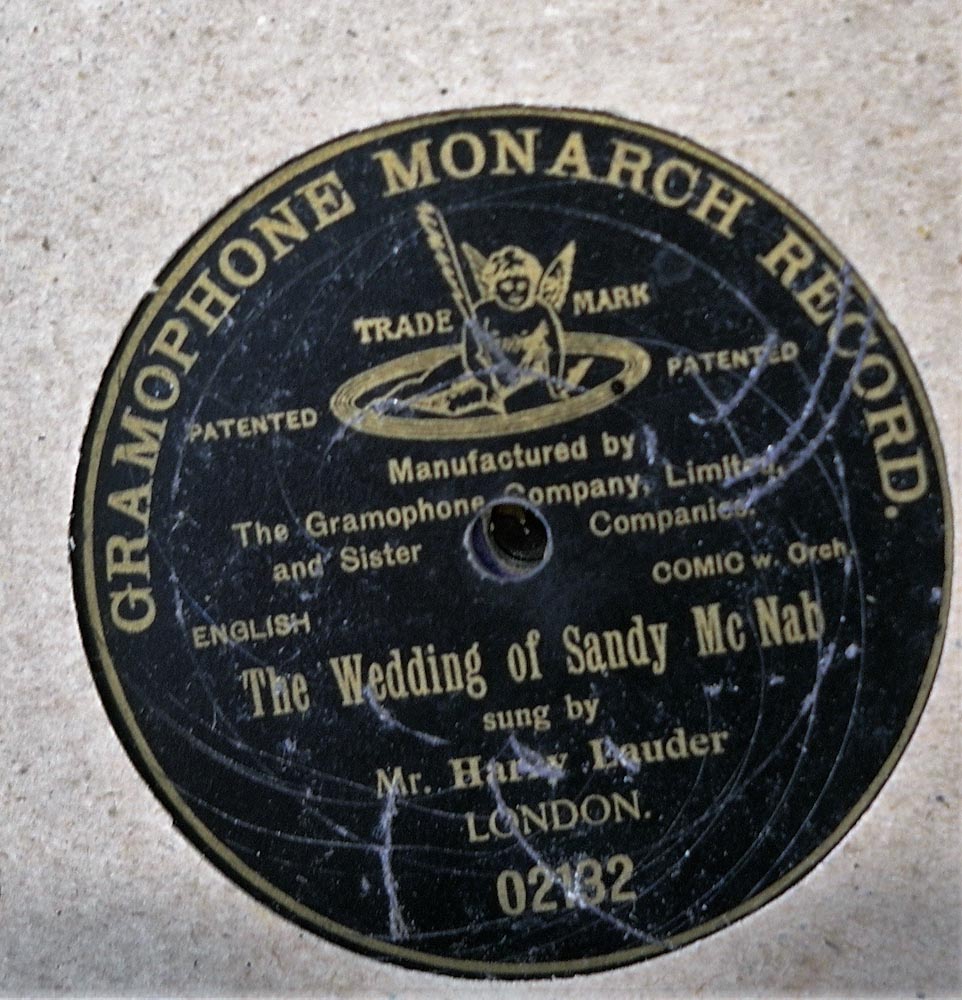Cecil Kimber’s Musical Tastes.
Cecil Kimber’s Record Collection
Visitors to Kimber House who climb the stairs to the offices above may sometimes notice a fairly large, old, and somewhat tattered red folder. The folder is heavy and contains some twelve 78 rpm records. The inscription at the bottom shows the folder was supplied by Chas. Taphouse of Oxford. The folder was given to the club some time ago by one of CK’s relatives. The title above is probably misleading, I think it may be reasonably asserted that CK had more than one folder, and more than twelve records amounting to thirteen tracks. (photo CK1)
Taphouse and Russell Acott were the two main outlets for recorded and sheet music in Oxford. Those of a certain age will remember that although short of funds, wherever there was a record shop it was possible to visit and listen to records for free. In Oxford both shops allowed potential customers to listen to a maximum of three records in booths. I soon discovered that if it was an especially cold day that requesting three jazz tracks prolonged the use of the warm booths, but raised quizzical eyebrows among the counter staff. The shop rule was a maximum of three people per booth. So popular was this arrangement that one often had to queue for a booth, especially on a Saturday. Having exhausted the patience of the staff, and listened to records for which there were no funds to purchase, all would leave sheepishly to descend upon the other shop. Russell Acott’s was based in the High Street, Oxford, Taphouse in Magdalen Street – both central locations. Modern trends in recorded music and the decline in demand for sheet music from the early 1980s were an enormous challenge for established music retailers. Acott’s has survived after moving premises to outside the city and specialising in musical instruments. Taphouse was unable to meet the challenge and was wound up in 1986.
The records in CKs collection are all 78s – most single-sided (photo CK2). Until the early 1950s, records were made from a shellac compound using the secreted resin from the female lac bug cultivated in India and Thailand. While shellac had good insulating properties and was immune to damp, it was heavy. The other serious limitation was the length of sound which could be placed on a disc, much classical music was at a disadvantage, but popular and music-hall recordings were ideal for this low fidelity format. Also popular were short operatic pieces where the inability to fully capture the orchestral backing was compensated for by the singer being heard more clearly and loudly. Both Caruso – who first recorded in 1902 – Chaliapin, and the Australian soprano Dame Nellie Melba’s recordings boosted sales of both records and home playing equipment. To give an idea of the limitation of length, Beethoven’s 5th Symphony which is about 35 minutes long, was available in the 1930s – but on eight separate discs! To find room for Wagner’s Ring Cycle would have required an extra room, probably. The high fidelity 33 rpm long player introduced in 1948 for the first time enabled many classical compositions to be played from one disc.
Some of CKs recordings date from the acoustic era,, when the process to capture the sound for a master disc was entirely physical. Some discs date from 1925 when electronic recording started with Western Electric’s new hybrid system. Although the process was still essentially acoustic in that a master die pressed a groove onto shellac, microphones and some electronic manipulation was possible before the sound was committed to the dies. This was the birth of the ‘sound engineer’ and of different styles of musical presentation – crooning and the big band sound for example. Discs started to replace cylinders by 1900, and because discs needed less storage space as well as other advantages, the 78 disc was the dominant medium by the end of the First World War. The later vinyl 45s and LPs were post-WWII developments.
With the hybrid recording system came an almost reverse process – the record player or gramophone. The electrical speaker was the approximate reverse of the microphone. Fidelity was much improved. We know that CK was paid a good salary by his employer, William Morris, so there is a very good chance that CK had bought one of the expensive, modern radiograms .available in the 1930s and which would have given fairly decent fidelity.
All the classical recordings dealt with here are available on YouTube, most of the non-classical are also available either on YouTube or elsewhere. While the precise recoding may not be available, the singer’s voice with a different recording can usually be found.
Cecil Kimber’s Records – caveats.
The collection may be divided into popular and light classic. As with many attempts to write an account based on sparse information (in this instance just the discs), what is absent may tell us something as well as what is present. What is absent in the CK record collection is jazz and music hall. Both mediums were greatly popular between the wars, but regarded as suspect in solidly middle-class homes.
Plenty of jazz recordings were available. The Dixieland Jazz Band with Louis Armstrong on trumpet first recorded before WWI, many others followed in the 1920s and 1930s. However, jazz linked to a number of disreputable associations in the minds of many middle-class people: it was racially liberal, was best enjoyed live in darkened night clubs where men and women mixed more freely, and where alcohol and drugs may have been available. It also encouraged ‘wild’ dancing. It was a world away from the concert hall and a symphonic orchestra. For many parents of teenage children early rock ‘n roll posed similar threats to their off-springs’ (apparent) innocence.
The second absence is that of music-hall singers and performers. These were very popular songs and the recordings corresponded to those which many had seen performed live in the often raucous atmosphere of the music halls. The songs often mocked the upper and middle classes, dwelt on sentimental aspects of working-class life, and frequently used double entendres and sexual innuendo. Recording artists spanning CK’s adult lifetime included such names as Albert Chevalier, My Old Dutch (a song about an elderly couple separated when forced into a workhouse), George Formby, When I’m Cleaning Windows (voyeurism), Ella Shields, Burlington Bertie from Bow (an aristocratic idler), and the most popular of all, Marie Lloyd with A Little Bit of What You Fancy Does You Good (sex), and She Sits Among the Cabbages and Peas (pees!). Finally, there was Max Miller, a comedian who did little else but sexual innuendo. We may conclude, with far from overwhelming evidence, that CK’s choice of records did not extend to those genres which although very popular, may have been regarded as somewhat risque in the middle class home of the era, and especially so in a home with daughters.
The records
Taking the first group – light classical – we start with Mendelssohn’s Wedding March (1842).(CK3) It was popularised when Queen Victoria’s daughter, Princess Victoria chose it for her wedding when she married Prince Frederick IV of Prussia in 1856.[i] CK’s choice of this piece is unsurprising. In the German early romantic tradition it has a memorable and pleasing melody. Taken from Mendelssohn’s music for Midsummer Night’s Dream, the piece accompanied Christian and secular marriage services across the globe, but latterly is heard less at weddings as modern trends for more bespoke ceremonies have gained pace. While CK’s domestic life has been described as ‘difficult’ and his daughter stated that “… emotionally my parents were poles apart”, for most the Wedding March brings back happy memories.[ii]
The next three discs in CK’s collection are connected: Grieg’s Peer Gynt Suite: – Death of Aase, Morning Mood, Anitra’s Dance, and Dance in the Hall of the Mountain King (CK4,5&6). All four pieces were and remain very popular, especially among those who like their classical music to have a melody and to conform to the traditions of European romantic composition. All are also an ideal length for the limitations of the post-1925 78s.
Eduard Greig wrote the Peer Gynt Suite for fellow Norwegian, playwright Henrik Ibsen’s play Peer Gynt, premiered in 1876. Aase, Anitra’s Dance, Dance in the Hall of the Mountain King, and Morning Mood are short pieces taken from a composition which is about ninety minutes long and originally consisted of 26 parts. Aase is Peer’s mother and the music is meant to comfort her as she approaches death. For a long time The Death of Aase was the most popular of the 26 pieces in the Suite; less so today. It is both sombre and melodic, and is somewhat minimalist for the era. It has been said that in many respects Aase is the forerunner of Samuel Barber’s Adagio for Strings composed in 1939.
Morning Mood from the same suite reflects the part in the play when Peer has been stranded in the Moroccan desert by his ‘friends’, and wakes up at dawn only to find that he is surrounded by a group of aggressive monkeys which he has to fend off with a stick. At four minutes long, the piece is unusual in that the climax occurs early on, reflecting the sunrise and subsequent activity. The main melody alternates between flute and oboe. It remains very popular.
Anitra’s Dance follows Morning Mood in that Peer has fended off the monkeys and meets a Bedouin chief in the hot Moroccan desert. He is very taken with the chief’s daughter Anitra who dances enticingly for him. The instruction for the orchestra on the score is Tempo di Mazurka. Dance in the Hall of the Mountain King is both widely known and has achieved iconic status due to its use in films, and its rearrangement for – oddly – heavy metal bands. Peer stands in the large hall in front of the king and is surrounded by gnomes, trolls, and goblins. However, as with many artistic ventures, Greig’s over-subtle intentions may well have been missed by many audiences.[iii] Greig wrote of his own composition:
“I have written something that so reeks of cowpats, ultra-Norwegianism … that I can’t bear to hear it, though I hope that the irony will make itself felt”.
As the topic is classical music, it is worth bearing in mind that as with all communities, the classical music world – both players and audiences – have their idiosyncratic conventions, including humour. For some reason I have never understood, just as rock music has its jokes about drummers and bass players, so the classical world has jokes about viola players:
- Why are viola players like teenagers?
- They come in late, and have usually lost the key.
CK’s next disc for consideration is the Miseréré from Il Travatore sung by Miss Alvena Yarrow and Mister Ernest Pike(CK7). Neither name will mean much to anybody who reads this, and for a good reason. Until the mid-1920s recording artists would use a multitude of names in order to surreptitiously break their contracts (probably the only advantage inherent in the poor sound reproduction), or, for reputational reasons, to record in genres they did not wish to be associated with. Eleanor Jones-Hudson (1874-1946) a.k.a. Alvena Yarrow was a Welsh soprano who used a total of 16 names throughout her career. Ernest Pike (1871-1936), his real name, used a total of 19 pseudonyms. Peter Dawson, the noted Australian baritone used 30 names as a singer, and another 9 as a composer. There is no parallel to this in today’s music communities.
The Miseréré occurs in the final act of Verdi’s opera, entitled Punishment. This is classic operatic pathos: the hero is in prison and ‘Leonora attempts to free him by begging di Luna for mercy and offers herself in place of her lover, but secretly swallows poison from her ring in order to die before di Luna can possess her’. This is pretty well the gloomiest disc in the whole collection.
This is one of the earliest recordings in CK’s record folder. It was recorded in 1905 using a full acoustic system and may have been manufactured much later, but if recorded acoustically no amount of manipulation will alter the limitations of the original recording. A superb recording of this piece by Maria Callas is available on Youtube.
The next of CK’s records is J.S. Bach’s Prelude and Fugue in C Minor (CK8). This is part of Bach’s Well-Tempered Clavier, a collection of preludes and fugues in all twenty-four major and minor keys. Bach wrote them for the experienced keyboard player, hence they are technically challenging in that all fingers of both hands are kept busy as essentially the fugue is a melody overlaid with a variation of the same melody. For the listener Bach’s fugues can be contemplative, so, unsurprisingly, they are frequently played in churches before a service or as a concert. Although the clavier is stated, at the time it was a generic name for any keyboard instrument, including the organ. CK’s version is piano. This particular piece has always been popular.
The next of CK’s records is Incidental Music from Monsieur Beaucaire (Intermezzo & Leit Motif) by André Massager. Premiered in Birmingham in 1919 this three-act comic opera is based upon a novel of 1900. Much of the music is in waltz-time, so that may explain some of its popularity. There is a good chance that CK actually saw this opera, perhaps in Oxford at the New Theatre (which like New College in Oxford is not very ‘new’). The basic plot is set in Bath, and involves the King of France’s son posing as a barber and therefore being misunderstood by everyone until – as much comical drama does – he is revealed in the final few minutes to be of French nobility. The plot involves cheating at cards, love rivalry, and duels. Generally the French characters are clever and attractive; the English characters are fools and cheats. It is no surprise therefore that the opera is rarely performed in the UK, but remains a staple of opera in France.
The final of CK’s records in the light classical category is Schubert’s Unfinished Symphony, referred to as No. 8, or sometimes No.7 (CK10). The Unfinished has only two movements, whereas four was then the norm. There is much speculation as to why Schubert abandoned his symphony. A musical explanation is that the meter or regularity of beats is the same for the two movements, and for the planned third movement. Three movements in the same meter would normally rule it out as a symphony. Rather like a novelist getting half-way through his book and realising that the plot has serious holes in it and a complete re-write is needed, better to abandon and start something else. Another explanation given is that Schubert was first diagnosed with syphilis while composing the Unfinished, but as he went on to compose much else this seems unreliable. Perhaps it remains popular precisely because it is not a symphony, but has two similar movements which are both melodic and contain low-level syncopation.
We now move to CK’s non-classical records. The first two can be dealt with together as they are both Wurlitzer pieces by the same organist, Jessie Crawford (CK11&12). Russian Lullaby was composed by Irving Berlin and At Sundown by Walter Donaldson. Jessie Crawford (1895-1962) was abandoned to an orphanage in California at 12 months, but managed to teach himself to play the cornet and eventually the organ[iv]. Initially a cinema organist in the silent film era, he gravitated to recording and concerts as the ‘talkies’ came in from 1926. His first instrument was the Wurlitzer, enormously popular, in part because of its versatility compared to conventional organs and pianos, but it was a spectacle in its own right – usually rising from the floor in front of the cinema curtains. It was also technically ‘modern’. Most large cinemas had a Wurlitzer or an imitation until after WWII. Crawford’s repertoire was considerable, and many of his recordings may be heard on:
http://theatreorgans.com/southerncross/Radiogram/ListeningRoom/thelisteningroom-crawfords.htm
At least one cinema in Oxford had a Wurlitzer where CK may have heard some of Crawford’s compositions and treatments, but Crawford also toured extensively, especially in the UK in the 1930s. He enjoyed sell-out concerts at the Leicester Square Empire. Embracing the modern, Crawford switched to the new Hammond organ in the 1930s. The Wurlitzer is one of those music forms which had a popularity somewhat baffling to today’s music audiences.
Ck’s next record Smoke Clouds sung by Basil Lloyd is pretty obscure. Nothing has been found about the singer, but the song was composed by Herman Darewski. Darewski, originally from Minsk where his father was a musician settled in London and became both composer and conductor of light music. Two of his other songs are ‘Ours is a Nice ‘Ouse Ours Is’ and the WWI song ‘Sister Suzie’s Sewing Shirts for Soldiers’ – both best sung sober I’d guess. Smoke Clouds was written for a review entitled Topsy Turvey (1915) which ran for eighty-eight performances at the Leicester Square Empire. CK may have seen the review either in London or on tour in Oxford.
CK’s penultimate record is Roses of Picardy sung by Geoffrey Anderson, recorded in 1918 (CK14). Composer Hayden Wood got the idea for the tune after familiarising himself with the Somme battlefields. Fred Weatherly provided the lyrics and had in mind a particular D’Oyly Carte soprano to record it, although most recordings were by tenors. The first recording was in 1916, so CK’s record is one of the early ones. The song is essentially about yearning and loss; the fleeting encounter between a soldier and a French woman in the chaos of war which comes to nothing. No trace of Geoffrey Anderson (if that was his name) has been found. The song was very popular among British soldiers and has subsequently been recorded hundreds of times and in many languages. After its release the song sold 50,000 copies of sheet music each month. It was often used after 1918 as an aid to treating shell-shock. One of the most recent recording of the song is by the British tenor Alfie Boe, who recorded it to be used in Downton Abbey in 2013.
We come to the last of CK’s record collection, Harry Lauder’s The Wedding of Sandy McNab recorded in 1909.(CK15). Sir Harry Lauder (1870-1950) was a Scottish singer and comedian in the vaudeville tradition. He started his working life as a coal miner. Winston Churchill described him as “Scotland’s greatest ambassador”. He was knighted in 1919 for services to the war effort. Lauder cultivated a stage presence of the ever-jovial Scotsman with his kilt, sporran, tam o’shanter, and cromach (stick). Bagpipes were absent. Perhaps he was aware of the following:
- What makes a true gentleman?
- A man who CAN play the bagpipes, but refrains from doing so.
Lauder’s three best selling songs are I Love a Lassie, Roamin’ in the Gloamin’, and, after his only son was killed on the Somme, (Keep right on to) The End of the Road.[v]
Lauder became enormously popular throughout the English-speaking world. While many of his songs were humorous, unlike many music hall entertainers his songs were never smutty. The Wedding of Sandy McNab is about a man who appears to have been destined for bachelorhood , has managed to be ‘hooked’ by a perhaps naïve young woman, and recounts some of the wedding reception. Some words from the narrated part of the song follow:
“Somebody objected to McNab sitting with his arms around the bride’s neck … the next thing I saw, McNab was sitting with his arms around the neck of a bottle” … (and the best man refuses to make a speech saying) “Mum’s the word. Stick to a pal when he’s down”.
Speculation of course, but one could wonder, on the basis of what we do know about CK’s domestic life, whether a song about an inauspicious marriage was more than three minutes of humour for the man who founded MG.
As I stated at the start of this article, there is a good chance that we have a snapshot of Cecil Kimber’s musical tastes rather than anything like the full picture. The red folder at the top of the Kimber House stairs may well be just one of many which were in the Kimber household. On the basis of the twelve discs, all we can say is that they likely reflect the tastes of a respectable middle-class household of the era. It is good though that someone connected to the Kimber family did think of the MGCC when deciding what to do with a collection which is now almost unplayable. I suspect though that the reason they have been on a table on the upper landing for some time, is due to our very able archivist Peter Neal being unable to find an appropriate spot in among the factory records, repair manuals, badges and the like. Also, as far as I am aware, Kimber House has no equipment capable of playing these discs.
Peter Cook
MGCC – Overseas Director. 4/11/2018
[i] As a footnote to the Wedding March, although Mendelssohn and his siblings were of Jewish parentage, they all converted to Lutherism as children. Even so, when the Nazis came to power Mendelssohn’s music was banned and the authorities sought a composer to create an alternative to the Wedding March. The sanctioned alternative composed by Karl Orff was not popular. Faced with the popularity of the Mendelssohn march and unwilling to impose an alternative an etiquette developed whereby the Wedding March would be played, but only after Nazi Party members had left the ceremony and waited outside. Where, no doubt, they could still hear it being played.
[ii] Jean Kimber-Cook, Cecil Kimber, By His Daughter Jean, Enjoying MG, V.12/1, January 1992.
[iii] In the UK Alf Garnett was received by many as reinforcement and legitimisation of their prejudices, whilst writer Johnny Speight and actor Warren Mitchell had intended the character, contrarily, to be a parody of a bigot; Bruce Springsteen’s Born in the USA was intended as a critique of American foreign policy and the government’s treatment of war veterans, but it became misunderstood and hijacked as a celebratory anthem.
[iv] http://theatreorgans.com/southerncross/Journal/More about Jesse Crawford – Foort.htm
[v] The circumstances surrounding the death of John Lauder were for a time uncertain and caused Sir Harry much distress. Initially it was claimed by some that John had been shot by a member of his own unit, where he was unpopular. For those interested in WWI history John Lauder’s death gives a fascinating insight into events.
http://www.sirharrylauder.com/the-mysterious-death-of/

